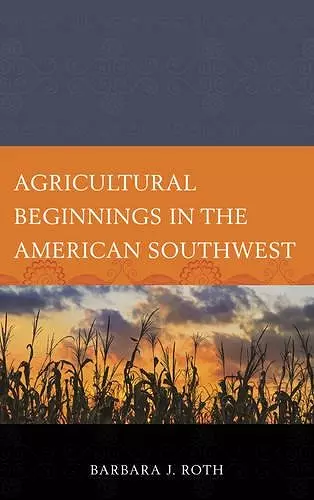Agricultural Beginnings in the American Southwest
Format:Hardback
Publisher:Rowman & Littlefield
Published:12th Oct '16
Currently unavailable, and unfortunately no date known when it will be back
This hardback is available in another edition too:
- Paperback£42.00(9781498582018)

How did agriculture come about in the American Southwest? What environmental and social factors led to the cultivation of plants? How, in turn, did the use of these new agricultural products affect the ancient peoples living in the region? In pursuit of answers to these questions, Barbara Roth synthesizes data from both CRM and academic research to explore the emergence and impact of Southwestern agriculture. Roth examines agricultural beginnings across the entire Southwest, both northern and southern, and across culture groups residing there. Beyond simply addressing the arrival and widespread adoption of specific cultigens, she pays particular attention to human factors such as patterns of production and variability in agricultural developments. Her consideration of broad social and environmental dynamics affecting forager diets and adaptive strategies sheds new light on what we know—and what we should ask—about the transition from foraging to farming.
This excellent book applies a range of conceptual approaches and an up-to-date data set to the analysis of agricultural origins—an important topic in the prehistory of the American Southwest and, more broadly, in World prehistory. I am not aware of any other recent, single-author publication that provides such a comprehensive review of the subject from across the American Southwest, including such thorough treatment of evidence scattered among what are often obscure (though generally well done) reports from the realm of contract archaeology. -- Richard Ahlstrom, HRA, Inc., Conservation Archaeology
In this much-needed new book, Roth provides a geographically-, temporally-, and thematically-focused consideration of the pivotal beginnings of agricultural societies in the Southwest. She synthesizes the best and most relevant CRM and academic data sets to lay out what archaeologists have found, the most appropriate behavioral patterns for making sense of the findings, and the recommended paths for creating more and higher-resolution knowledge regarding why, how, and to what effect hunter-gatherers in the Southwest incorporated cultigens into their diets and lifeways. -- John R. Welch, Simon Fraser University
A standby for students of southwestern archaeology at both the undergraduate and graduate levels. Roth’s writing is clear, direct, and eminently readable. -- Francis E. Smiley, Northern Arizona University
A much needed and excellent review of one of the most significant processes in human history. Although studies of the Southwestern Archaic have generally been neglected, a variety of new insights have been suggested through current CRM projects across the region. Most importantly, we are beginning to see regional variability in past foraging societies that encompasses the integration of cultigens into existing subsistence economies. Roth’s new book brings together this varied data set and provides new perspectives highlighting this regional variability and the diversity of forager-farmer behavior. -- Bradley J. Vierra, Statistical Research Inc.
The Three Sisters—maize, beans, and squash—along with their cultivated cousins altered forever the human experience in much of the Americas. Barbara Roth’s Agricultural Beginnings in the American Southwest is the must read summary of what we now know about one of the great human transformations in one of the most archaeologically interesting places in the world. She not only summarizes a wealth of previous research by dozens of scholars but points the way forward for future research. -- Paul Minnis, University of Oklahoma
Finally! This synthesis of early agriculture in the US Southwest is desperately needed and will undoubtedly become a standard resource. Roth emphasizes regional diversity and grounds her discussion in the realities of forager lifeways, providing insight that will be valuable to those working outside the region, too. -- Maxine McBrinn, curator of archaeology, Museum of Indian Arts and Culture / Laboratory of Anthropology
Roth weaves a complex, variable, and diverse story of the absorption of agriculture into the Southwest. In addition to extensive discussion of hard data, both old and new, she examines several theoretical aspects that touch on critical issues. These include how (and why) agriculture was adopted by local hunters and gatherers, ritual and ideology, social issues, demography, why agriculture was more successful in some regions than others, methods of agricultural transmission from Mexico, and the often ignored but important concept of interactions between farmers and non-farmers. This will be a significant and insightful resource for years to come, not only to Southwestern archaeologists but to anyone interested in the complex story of how agriculture changed the world. -- Alan H. Simmons, Distinguished Professor of Anthropology, University of Nevada, Las Vegas
- Winner of 2017 New Mexico-Arizona Book Award, Anthropology/Archaeology.
ISBN: 9780759121713
Dimensions: 239mm x 157mm x 16mm
Weight: 431g
200 pages